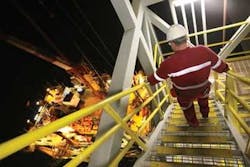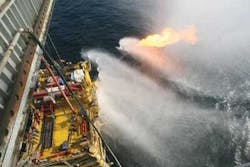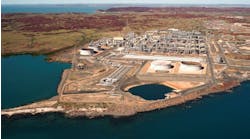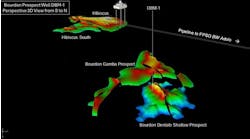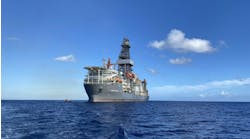John Waggoner - Technology Editor, Drilling & Production
Shell has a new way to drill and to prepare a well ready for start-up in the North field of Qatar that accelerates well delivery to significantly reduce costly rig time.
The Pearl GTL project was the first in Qatar to undertake drilling and completion operations, while simultaneously performing perforation, stimulation, and clean up operations on previously drilled and completed wells (SIMOPS).
In the past, taking 75 days to complete a production well in the North field was considered a good performance. With the new technology, Shell slashes the average total operation time to only 45 days per well. On average, 10 days on each well are saved through faster drilling and another 20 days by carrying out activities in parallel. Pearl is on track to deliver 22 wells with a total saving of more than 600 days relative to what was considered good performance. This translates into a projected savings of $135 million.
Shell’s SIMOPS concept originated as part of its partnership with state-run Qatar Petroleum (QP) to develop a world scale gas-to-liquids (GTL) plant, with QP challenging Shell to introduce new technology and innovation to beat the norm and achieve bottom line savings.
“When you start doing something you have never done before, you are never sure if it is going to work out,” says Anton Vos of Qatar Shell. “We showed that innovation, that thinking outside the box, can make a lot of savings.”
“We started off with just a concept. It was important to have enough lead time because it takes a while. That and a ‘can-do’ mentality,” says Bart Lismont of Qatar Shell.
Early on, many ideas were generated to optimize the drilling and completion stages of the wells. Since it appeared little could be done to reduce the time needed for perforation, stimulation, and cleanup, the idea was born to perform them “offline,” or in other words concurrently with drilling later wells.
Rethinking the rig
Before SIMOPS was selected, other ideas were proposed to save money, like performing offline operations with a cheaper vessel such as a service barge, but these still did not address the challenge of reducing rig time. Shell found these activities could be conducted more efficiently by approaching them on the same facility, but in an essentially new way.
“The first thing that was realized is that if more activities needed to be performed simultaneously, more people, equipment, and materials would be required at the work place at the same time. If all these activities would be performed from the drilling rig, a significantly larger drilling rig would be required than those commonly used to drill development wells in Qatar,” says Lismont.
While planning SIMOPS activities, it became clear that the rig’s POB capacity of 120 would not suffice. With both drilling, and perforating/stimulation/clean-up operations ongoing, more space would be required. The most cost effective way was found to be to upgrade the accommodation to a POB of 130. This was driven mainly by the required change out of the lifeboats. The existing 60 person lifeboats could be changed to 65 person lifeboats at a minimum cost because these are available “off the shelf” from the drilling contractor.
The advantage of more POB is that several activities can be performed more efficiently. However, it also increases the total exposure of crews.
“A higher number of around 160 POB would be ideal since it would reduce the amount of shifting of people on and off for a short duration. The required upgrades however made any further increase uneconomic. Having operated the rig for around a year now, the original decision to remain with 130 POB still looks like the right choice,” says Vos.
The decision to perform the perforating from the temporary platform deck under the rig’s cantilever meant an increase in the distance between the underside of the cantilever, which in normal operations is just a couple of feet, to a distance of 90 ft (27 m).
This increase, together with the requirement for lifting and hoisting equipment, led to most upgrade requirements for the rigs. The range of modifications demanded were not so challenging from a technological point of view, but required extraordinary planning.
“The upgrades are, in principle, not difficult or high tech. It is just the multitude of upgrades required and therefore the attention to detail that you need to make the overall project a success,” says Lismont.
Noble ended up winning the contract with a newbuild Friede and Goldman JU-2000E design rig. Later, Noble joined the team as a drilling contractor to convert the SIMOPS plan into a conceptual design. During this phase, Shell concluded it would be best to separate the online drilling and completion activities as far as possible from the offline stimulate, perforate, and clean up activities. This meant that most if not all offline activities would be performed from temporary drilling decks.
The question was how to go about it. Not the least of the concerns was the realization that to get around a rig jacked up high above the platform for offline activities, personnel would have to scale what amounted to nine stories in the scorching heat.
Some examples of things that required modification were:
- Lengthening of crane and lifeboat wires to reach sea level from the higher rig elevation
- Deep well pumps that supply the rig with seawater had output pressure raised to compensate for the higher elevation
- Cameras were installed on the tip of the crane booms to ensure the crane drivers have a good view of supply boats
- A very long stair tower with an elevator was needed to reach the top of the platform deck 90 ft (27 m) below.
Upgrades to temporary decks
Temporary platform decks were designed originally to perform work on the wellheads and christmas trees during well construction. These decks are removed once the well construction is complete, prior to the installation of the permanent platform topsides. Since these decks are mainly for access only during the limited time of the well construction activities, they are light and simple.
For SIMOPS, much higher requirements on these decks were called for to fit a slick line wire line unit, a braided line wire line unit to perform the perforating, and enough space for wire line workshops, lubricators, and other equipment.
During cleanup, the well is produced at rates of 100 MMcf/d to remove the completion fluid, clean the perforation tunnels, and remove the spent acid after stimulation. For this, a separate deck was planned to keep the cleanup equipment apart from the wire line equipment.
One additional deck was included in the original temporary platform decks, which was originally intended for testing the main gas pipeline to Ras Laffan.
Normally during well tests and well cleanup activities, the flare booms required to burn the produced gas and condensate are mounted on the drilling rig. The decision to separate the offline and online activities meant that these flare booms had to be platform mounted.
Accordingly, a high specification deluge system is needed to keep the heat radiation within acceptable levels. Optima, a specialty company, supplied nozzles that create a fine mist instead of the more common water spray system to cool down parts of the installation heated by the flare. The deep well pumps on the rig lacked sufficient capacity, so instead of upgrading the system and having to pump the water from the sea level all the way up, a separate water supply system was mounted on the platform deck. This deluge water supply system consists of two deep well pumps and two booster pumps capable of supplying 2,500 gpm at 250 psi. (9,464 lpm at 1.7 MPa).
Other add-ons typically not found on temporary decks include:
- Fire and gas system
- Platform ESD system
- Permanent platform lighting
- Utility supply lines such as water, air, and diesel
- H2S breathing cascade system
- Life rafts.
Ideally, all these systems would be installed in the yard. However, constraints on crane barge time meant some had to be added during the drilling of the first wells before the real SIMOPS could start. Although this solution took a couple of months, it gave the crews a taste of SIMOPS with its inherent communication requirements before the real activities started, say Lismont and Vos.
BOP, riser modifications
During the planning phase, it was decided that with the 120-ft (36.5-m) air gap, the BOPs should be left at the rig level. This was useful because placing the BOPs there does not interfere with the work taking place on the platform.
“The downside is that for this set up the long high-pressure riser needs to be designed to support the weight of the BOP stack. This required detailed design to ensure that the riser can withstand the buckling forces,” says Vos.
This BOP would have to be located inside the rig’s cantilever, together with the special “spider deck” so that the total cantilever is enclosed to avoid the risk that objects might fall to the top of the platform deck. Accordingly, two high-pressure risers had to be manufactured: one 20 ¾-in. riser and one 13 5/8-in. riser.
The total length of these risers is 115 ft (35 m), about 100 ft (30 m) more than a typical jackup in this region. UWG was hired for a structural analysis of the riser, and concluded that a normal riser was strong enough to carry the complete weight of the BOP. The only lateral support required to contain buckling was right at the top of the BOP, where it is connected to the diverter housing mounted below the rig floor. Additional supports, while tempting, would be counterproductive.
“Providing more lateral support means more resistance to buckling. However, since the rig and the platform are two independent structures that both move under the influence of wave and wind forces, this increased support would mean higher bending forces in the riser and therefore a worse solution,” says Vos.
The original rig design called for a conductor tensioning platform (CTP) at the back end and inside of the cantilever. This so called “box” could move up and down into this moonpool, providing conductor tensioning as well as some protection while working in this area when the rig would be operating in free standing mode.
With the gantry cranes installed underneath the cantilever deck, however, the CTP would be impossible to operate. Friede Goldman was asked to design a more traditional BOP deck to allow easier access and provide a safe area to work. A 15 in. (38 cm) gap runs over the length of the BOP deck to allow the drilling risers to pass through. The holes are covered with deck hatches when unused.
To provide a high volume pressure test and well kill line to the platform, a 2-in. (5-cm) high-pressure line was installed to service the operations on the platform. The line consists of 2-in. hard piping from the cement unit inside the cantilever deck to the moonpool, where it changes into a Coflexip hose on a specially designed hang off point before going down to the platform.
All services on the platform come from the rig. All power for lighting, the platform crane, and the deluge water pumps are from the rig. Rig air, breathing cascade system air, and diesel are from the rig through utility lines routed via the stair tower and the platform access bridge. The same route is used for the fire and gas system signals, the rig’s communication system, and the rig-mounted platform ESD system.
In conclusion
The significant time and effort Shell devoted to introduce SIMOPS in the North field in Qatar resulted in some 20 days of rig time reduction per well. Combined with a further 10 days reduction through faster drilling, total projected savings amount to 600 days or $135 million relative to what was considered good performance.
The SIMOPS concept required extensive modifications to accommodate additional temporary decks and more people on board. Photo courtesy of Shell.


